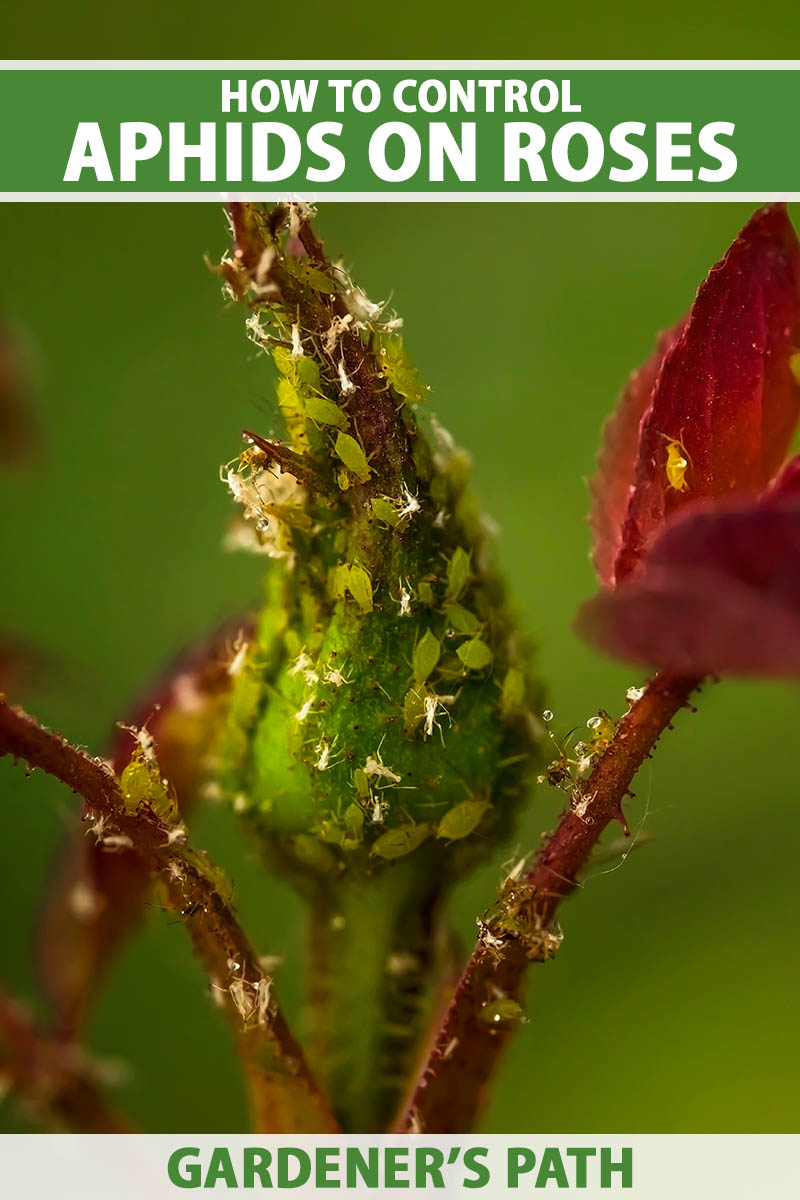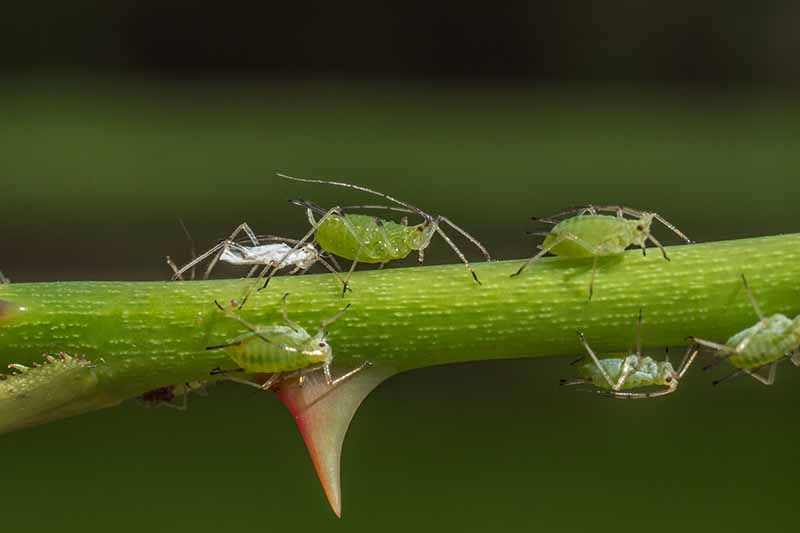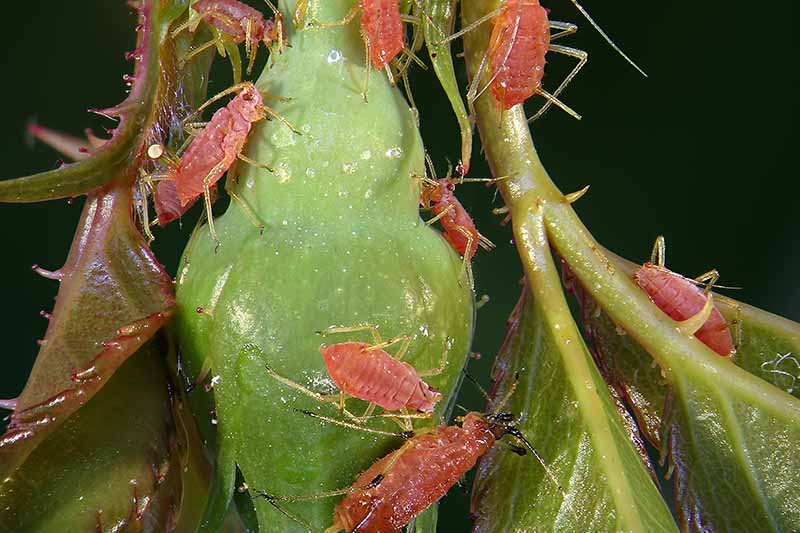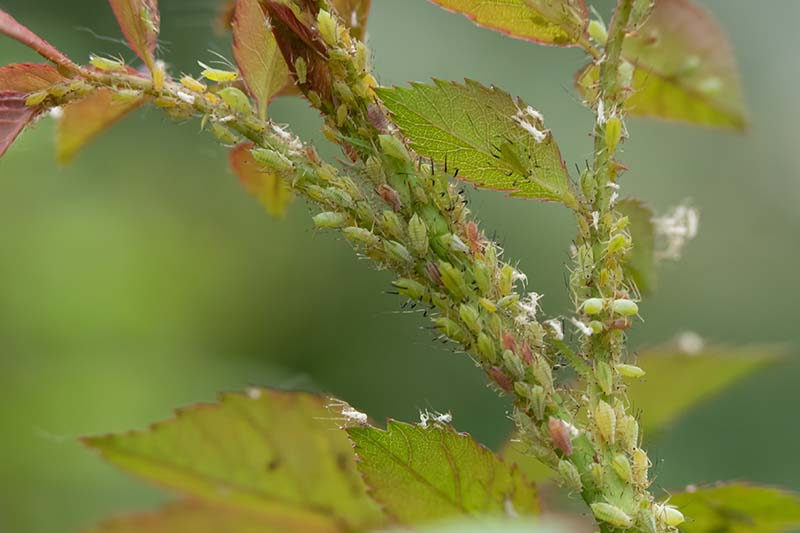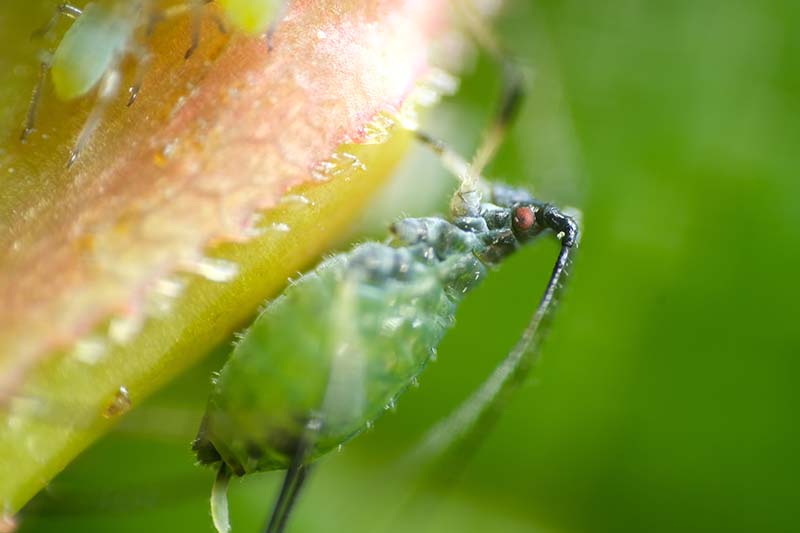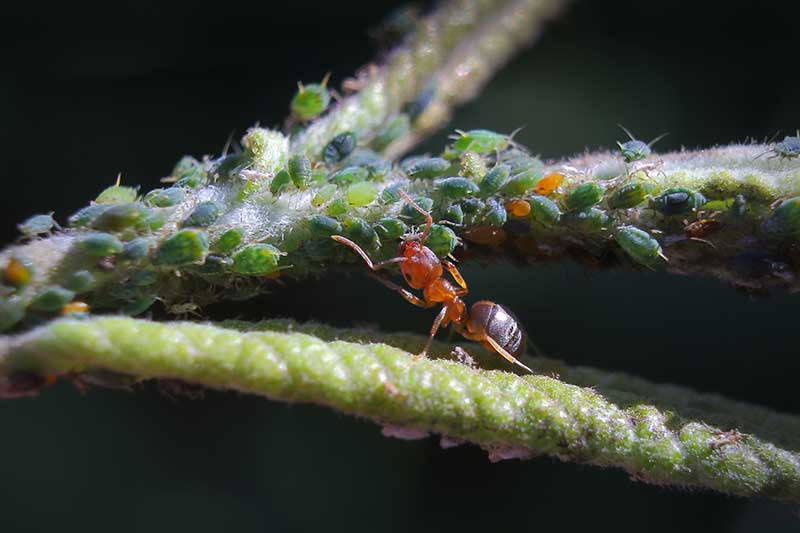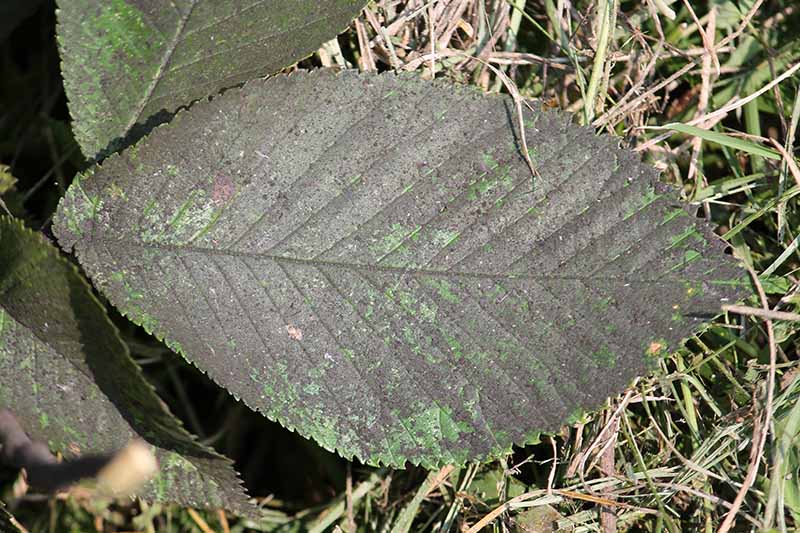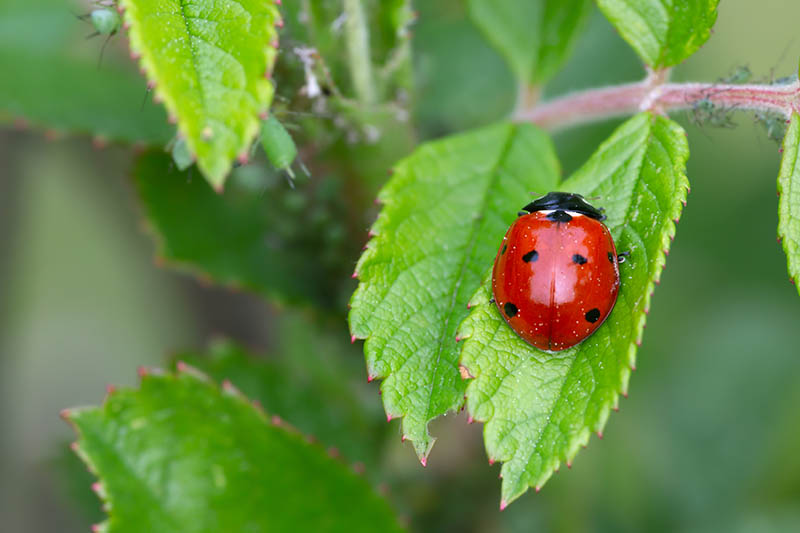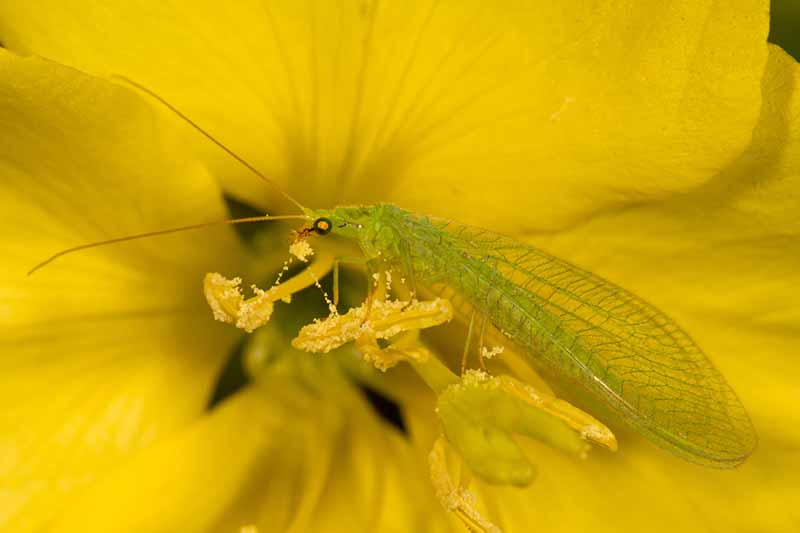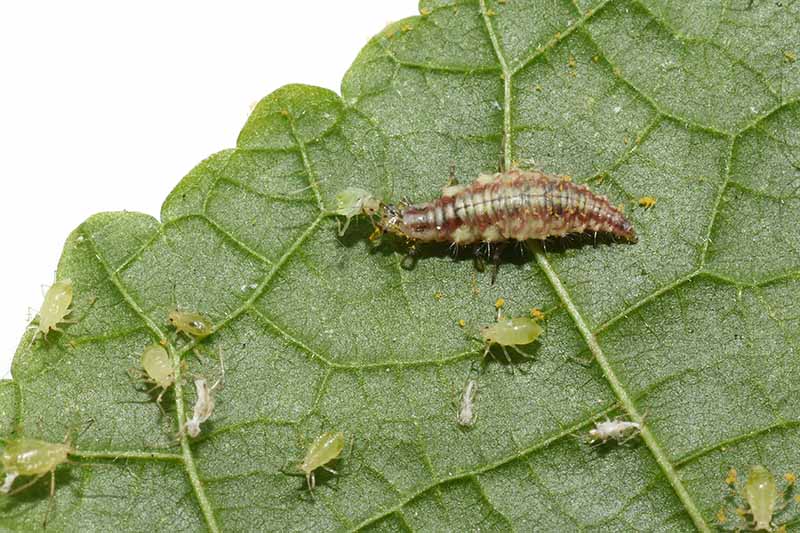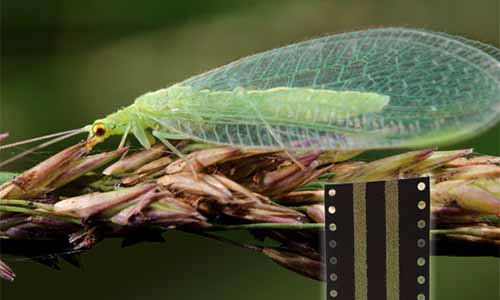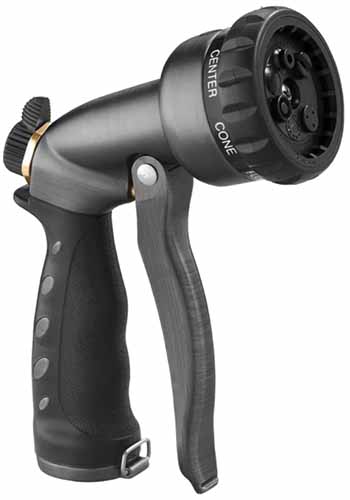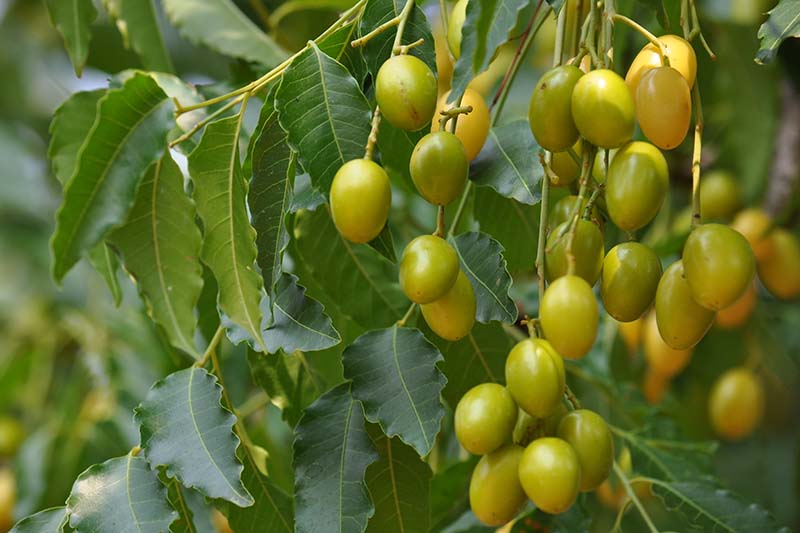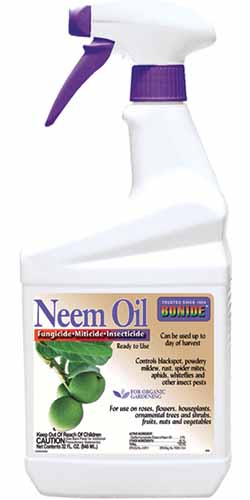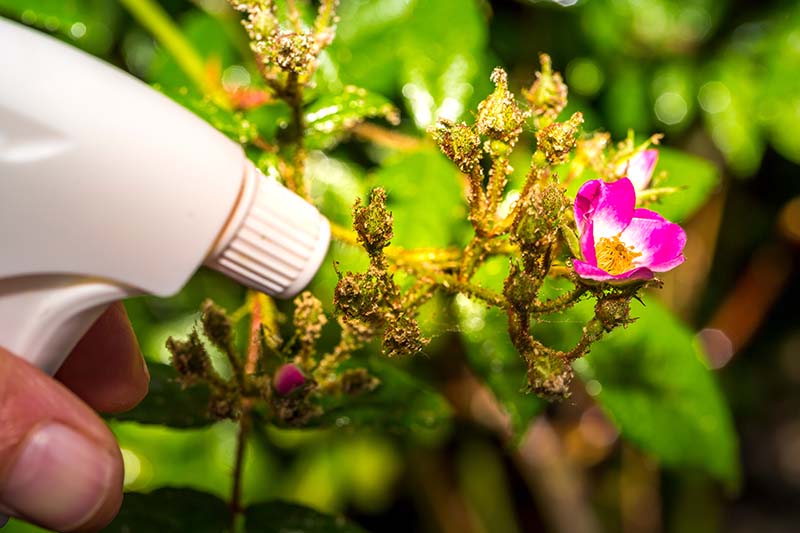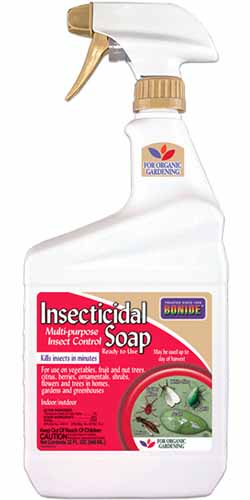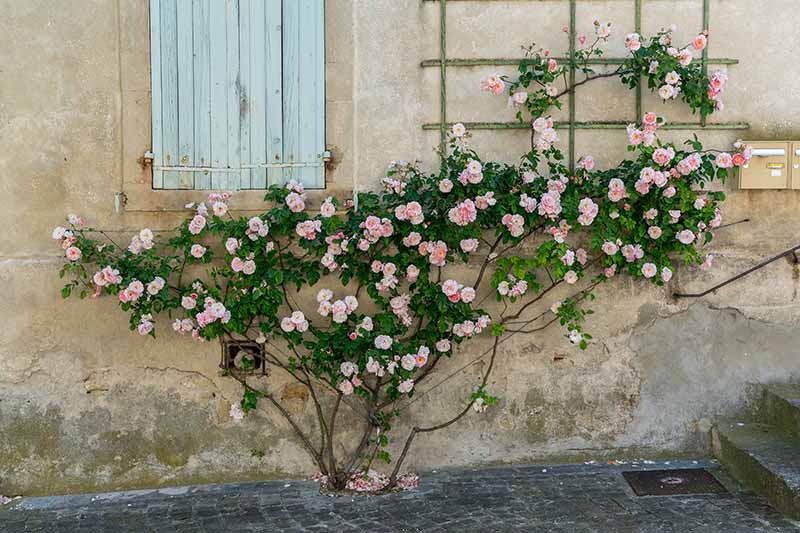You lean in closer, and see that some of the flower stems and buds are covered in small, pear-shaped insects, typically green or pink but they may appear in other colors as well. What are they? Aphids. The pesky creatures are feasting on your dazzling plants and you must get them off – but how exactly do you control aphids on roses? We link to vendors to help you find relevant products. If you buy from one of our links, we may earn a commission. If you want to learn more about how to grow roses (Rosa spp.), check out our guide. Here’s what we’ll dig into:
Meet the Aphid
Aphids will infest nearly every living plant they can get their tiny, threadlike legs on. These soft-bodied true bugs are members of the superfamily Aphidoidea and can be found all over the world, although they are most common in temperate climate zones. These tiny pear-shaped insects are usually between two and four millimeters long and come in many colors: black, white, green, pink, and orange, to name a few. Of the 4,000 aphid species that have been identified, about 250 are considered crop and ornamental plant pests. The green or pink three-millimeter-long Macrosiphum rosae is the rose’s main attacker, although other species can feast on your roses, too. They can’t move far on those tiny legs, which is why you’ll often see them clustered up on a stem, sometimes in multiple stacked layers of tiny bodies. Possibly the creepiest thing about them is that when females are born, they are often already pregnant with more females. No males are needed for this. These highly fertile females emerge via live birth, as opposed to needing to develop in an egg outside the mother aphid’s body, so it’s easy for aphids to rapidly increase in number. But that’s not all. As fall approaches in temperate zones, the insects mate and lay eggs containing both males and females. If a plant gets too crowded, some of these young aphids can develop wings to help them float along on air currents and find new plants to suck on. Honestly, I think that’s kind of cool, even though I’m still not a fan of the pests. These insects keep laying eggs into the fall, but if it gets too cold for the bugs to hatch, they simply overwinter in the eggs and hatch in the spring. With about half a billion ways to reproduce (just a slight exaggeration), it’s easy to see how the aphid population can skyrocket and spell trouble for a plant.
Why Aphids Are Bad for Roses
Their prolific breeding habits are one reason why it’s important to curb infestations early, if you can. The bugs can cause significant damage to a rose, sucking the life out of buds before they have a chance to develop into fragrant blossoms, and removing so much sap from leaves that they wilt. This is because aphids have just one source of nutrition: plant sap. And they need to drink a lot of plant sap to get enough protein to survive. Plant sap contains a lot of sugar and not much protein, and this is bad news for your rose bushes for two reasons: First, the more sap the aphids suck, the more your plant suffers. Second, the bugs can’t use all the sugar in the sap they drink, so they end up excreting it all over the place in the form of honeydew. The presence of honeydew can then attract fungal spores that develop into sooty mold, a disease caused by a variety of fungi in the Aureobasidium, Capnodium, Fumago, Fumiglobus, Limacinula, and Scoriasntennariella genera. The fungi that cause sooty mold feed on honeydew and will spread all over a plant wherever the honeydew is present. Oh, and ants love honeydew and will protect herds of aphids in order to get it, milking them in order to get them to secrete the sweet substance, which they then drink up. Nature is so weird. And while many people know that ladybugs love to eat aphids – we’ll talk about their role in keeping aphids away in a moment – you have to consider the relationship between ladybugs and ants, too. Ants don’t eat ladybugs, but if ladybugs feel outnumbered by groups of ants that are protecting the aphids, they will fly away. So keep an eye out for ants, and if you see them on your rose bushes, target them with the same three methods recommended below to control aphids. But back to sooty mold: If your roses are covered in it, the plants are less able to absorb the light and nutrients they need to thrive. Thankfully, sooty mold doesn’t infect the actual plant tissue and wiping the mold off will rid your plants of issues. But this can be a hassle and a severe infection can even cause a plant to die from lack of appropriate nutrients, especially if the spread is left unchecked. Unfortunately, aphids can also transmit viruses every time they suck plant sap. You can learn more about aphids in our guide. So how can you keep these pesky pests off your plants – or get rid of them once they arrive? Here are our three top methods.
3 Tips for Keeping Aphids Under Control
In addition to the three helpful tips described below, please keep in mind that this is always of the utmost importance if your aim is to control these pests: check your plants closely at least once a week. Since the aphids that attack roses are most commonly green or pink, small populations might not be easy to see from afar. Visiting your plants regularly and keeping an eye out for signs of infestation is your first line of defense. So lean in, smell the roses, and keep your eyes open while you do it. Check developing buds and the undersides of leaves, as these pests love to congregate and feast on these areas. It’s also important to note that none of these methods will be a one-time thing if you’re growing roses in the garden. In most cases, you’ll want to combine these suggested control methods to ensure that they’re as effective as possible, and to keep the insects from infesting your plants over and over again. Now, let’s look at each tip in detail.
1. Attract Aphid Predators to Your Garden
Okay, here’s a sad secret: there’s really no effective way to prevent aphids from coming near your plants altogether. If they’re around, they’ll probably find your roses at some point. And if you live in a place where plants grow, there are aphids around. But there are ways to help keep their populations low. One of the easiest ways to do this is to plant flowers and herbs that attract beneficial predators to an area near your rose garden, or mixed in among your plants. Predators like green lacewings and ladybugs feed off of pollen and nectar, but they don’t hurt plants. And they also eat aphids. Lots of them. Mature ladybugs (Coccinellidae spp.), which are typically around half an inch in size or smaller, can devour as many as 50 every day. Their larvae, which look like “little alligators,” according to garden writer Deb Courtner in a 2013 article published in the Denver Post, consume as much as five times that many despite their tiny size – a length of one-quarter of an inch. And with their black or gray tapered bodies, which are ridged and spotted with orange, the immature ladybugs really do look like little alligators, if you ask me. Some well-meaning gardeners mistake them for pests, which couldn’t be further from the truth. To attract ladybugs, plant angelica, chives, cilantro, coreopsis, cosmos, geraniums, marigolds, oregano, Queen Anne’s lace, and yarrow among your roses, or at least within a few feet of them. Place stepping stones in your rose garden, too, because ladybugs love to curl up in small, enclosed spaces. Fortunately, green lacewings (Chrysopa spp.) feed off of many of the same plants ladybugs do, including coreopsis, cosmos, Queen Anne’s lace, and yarrow. They’re also particularly fond of goldenrod and Marguerite daisies. Mature lacewings are about three-quarters of an inch in size. Like ladybug larvae, lacewing larvae eat aphids, too. The brownish, half-inch-long larvae are tapered at the front and back ends, and fat in the middle. Since these predatory insects will not harm you or your other plants, and help keep your rose garden healthy, it’s important to ensure that the space is hospitable to these insects, and predator-friendly.
2. A Hose Is Your Best Friend for Small Infestations
Say you discover a small aphid population during one of your weekly or twice-weekly searches. You see maybe a handful of the insects scattered throughout part of your rosebush, on leaves and unopened buds. If you want to ensure the presence of ladybugs and keep aphid populations down, first create a habitat that’s welcoming to them, and then you may consider purchasing live ladybugs for release. Be sure to look for ones that have been raised in captivity rather than ladybugs collected from the wild and shipped elsewhere. Some might just stick around after they do their work, although most will eventually fly away. In the case of an aphid infestation emergency, release 1,500 ladybugs per each large rosebush, and a week later, release another set of 1,500. Make sure to carefully follow package instructions when you release them to ensure that they don’t just immediately fly away. One of the key things to do is spray the plants with a light mist of water before releasing the ladybugs. They’ll appreciate the moisture, and it will encourage them to stay in the area. Setting a wet rag on the ground where you release them is also a good way to provide them with a water source and keep them on the battlefield. Refresh the rag every day for best results. Lacewing Eggs You can do the same thing to get a head start on the lacewing population by purchasing green lacewing eggs from Arbico Organics as well. Release the eggs as soon as you receive them. Mist the foliage with water, and distribute the eggs evenly. They should hatch in three to 10 days. The best time to spray them away is in the morning, when there’s plenty of time before the cool of the evening sets in for the sun to dry off the plants. Orbit Adjustable Hose Nozzle I have this nozzle at home, and I use a semi-gentle setting like “shower” or the slightly more forceful “flat” to help spray the bugs off my flowers. After spraying once, check the bushes again the next day. You may need to spray more aphids off with the hose. Keep in mind that you don’t want to repeatedly pummel your plants with water as this may damage flowers and foliage. Try the gentlest spray setting first, and if that doesn’t work, gradually increase the force until the aphids come off. If they keep coming back, you may need to try something else. Which brings us to the third tip.
3. Treat Roses with Organic Pesticides
I have never seen one in person, but I love neem trees. Or at least I am a fan of the oil extracted from the fruits and seeds of the neem tree (Azadirachta indica), an evergreen native to the Indian subcontinent and much of Africa. Neem oil contains the natural pesticide azadirachtin, as well as additional complex insecticidal components that are not fully understood. When insects ingest it, the azadirachtin acts as an anti-feedant, which prevents aphids from eating and is also toxic to these pests. This results in the death of the hapless aphids who eat it. The azadirachtin in neem oil also disrupts the insects’ hormonal systems, which prevents them from laying eggs. Some neem oils on the market don’t contain azadirachtin and are described as “clarified hydrophobic extract” of neem oil. While the spray is generally recognized as safe for our beloved predatory ladybugs and lacewings, it isn’t exactly an ideal substance for these insects to ingest. I use this clarified hydrophobic extract of neem oil in concentrated form from Bonide, available at Arbico Organics. Bonide Neem Oil Follow package instructions to mix the concentrate with water and spray it on your roses at the first sign of aphids, after you’ve washed them off with the hose. And it can be especially toxic to helpful pollinators like bees if sprayed in large quantities. Thankfully, if you follow the directions on the label, ladybugs will most likely not be harmed. Neem oil is not a knockdown pesticide in the sense that it doesn’t contain chemicals that immediately kill pests, although it can smother any insect that is sprayed with it. Instead, to quickly recap, it works like this: you spray it on the leaves, new stems, and buds. The aphids come along and do their dastardly chewing. They ingest the neem oil along with the leaves, and then get sick, can’t eat, and die. Ladybugs and other predatory insects that don’t chew leaves probably won’t ingest any neem oil, unless it’s by accident. But if they eat aphids who have eaten neem oil, that could pose a problem. The bottom line is to take care when spraying neem oil, and don’t use it as a first line of defense if you can help it. Insecticidal soap is a bit safer for ladybugs. It kills soft-bodied insects like aphids by penetrating their bodies and destroying their cells. Bonide Insecticidal Soap I recommend this insecticidal soap from Bonide, available through Arbico Organics.
Bug Off
Now that you’re armed with the knowledge you need and organic methods to try for keeping aphids from devastating your rose plants, you can grow your roses in peace. In many cases, you’ll find that you need to combine two or more of these methods in order to keep aphids away from your roses. For example, plant herbs and flowers to attract beneficial insects (Tip 1), hose aphids away if you find small infestations (Tip 2), and spray the plant with neem oil or insecticidal soap to help prevent the bugs from returning in full force (Tip 3). Put together, these methods can help keep your roses happy and healthy – all while having a minimal impact on the environment surrounding your beloved plants. And if you encounter further issues with keeping your roses alive and well, please leave us a comment below! We love to hear from you. Plus, we’ve got several other guides to help you grow happy, healthy roses to read next:
How to Identify and Treat Common Rose DiseasesHow and When to Deadhead Roses5 Tips for Pruning Roses Like a ProHow to Winterize Roses
